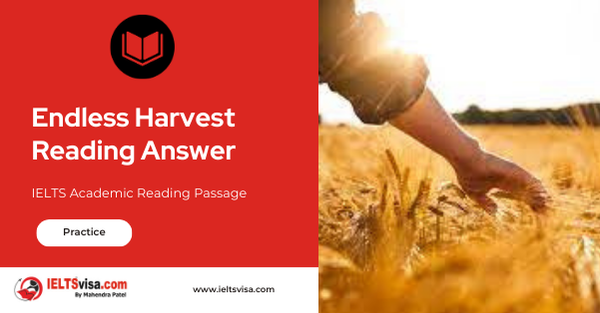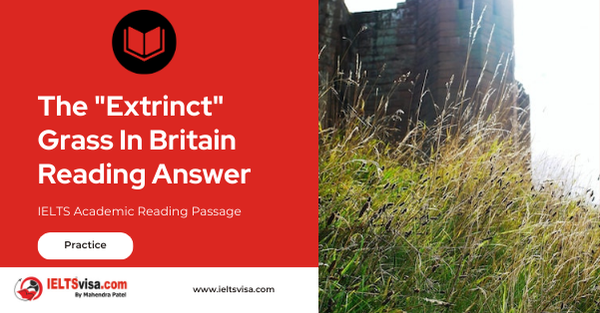Endless Harvest Reading Answer
IELTS Academic Reading Passage
More than two hundred years ago, Russian explorers and fur hunters landed on the Aleutian Islands, a volcanic archipelago in the North Pacific, and learned of a land mass that lay farther to the north. ‘The islands’ native inhabitants called this land mass Aleyska, the ‘Great Land’; today, we know it as Alaska.
The forty-ninth state to join the United States of America (in 1959), Alaska is fully one-fifth the size of the mainland 48 states combined. It shares, with Canada, the second longest river system in North America and has over half the coastline of the United States. The rivers feed into the Bering Sea and Gulf of Alaska – cold, nutrient-rich waters which support tens of millions of seabirds, and over 400 species of fish, shellfish, crustaceans, and molluscs. Taking advantage of this rich bounty, Alaska’s commercial fisheries have developed into some of the largest in the world.
According to the Alaska Department of Fish and Game (ADF&G), Alaska’s commercial fisheries landed hundreds of thousands of tonnes of shellfish and herring, and well over a million tonnes of groundfish (cod, sole, perch and pollock) in 2000. The true cultural heart and soul of Alaska’s fisheries, however, is salmon. ‘Salmon,’ notes writer Susan Ewing in The Great Alaska Nature Factbook, ‘pump through Alaska like blood through a heart, bringing rhythmic, circulating nourishment to land, animals and people.’ The ‘predictable abundance of salmon allowed some native cultures to flourish,’ and ‘dying spawners* feed bears, eagles, other animals, and ultimately the soil itself.’ All five species of Pacific salmon – chinook, or king; chum, or dog; coho, or silver; sockeye, or red; and pink, or humpback – spawn** in Alaskan waters, and 90% of all Pacific salmon commercially caught in North America are produced there. Indeed, if Alaska was an independent nation, it would be die largest producer of wild salmon in the world. During 2000, commercial catches of Pacific salmon in Alaska exceeded 320,000 tonnes, with an ex-vessel value of over $US 260 million.
Catches have not always been so healthy. Between 1940 and 1959, overfishing led to crashes in salmon populations so severe that in 1953 Alaska was declared a federal disaster area. With the onset of statehood, however, the State of Alaska took over management of its own fisheries, guided by a state constitution which mandates that Alaska’s natural resources be managed on a sustainable basis. At that time, statewide harvests totalled around 25 million salmon. Over the next few decades average catches steadily increased as a result of this policy of sustainable management, until, during the 1990s, annual harvests were well in excess of 100 million, and on several occasions over 200 million fish.
The primary reason for such increases is what is known as ‘In-Season Abundance-Based Management’. There are biologists throughout the state constantly monitoring adult fish as they show up to spawn. The biologists sit in streamside counting towers, study sonar, watch from aeroplanes, and talk to fishermen. The salmon season in Alaska is not pre-set. The fishermen know the approximate time of year when they will be allowed to fish, but on any given day, one or more field biologists in a particular area can put a halt to fishing. Even sport fishing can be brought to a halt. It is this management mechanism that has allowed Alaska salmon stocks – and, accordingly, Alaska salmon fisheries — to prosper, even as salmon populations in the rest of the United States are increasingly considered threatened or even endangered.
In 1999, the Marine Stewardship Council (MSC)*** commissioned a review of the Alaska salmon fishery. The Council, which was founded in 1996, certifies fisheries that meet high environmental standards, enabling them to use a label that recognises their environmental responsibility. The MSC has established a set of criteria by which commercial fisheries can be judged. Recognising the potential benefits of being identified as environmentally responsible, fisheries approach the Council requesting to undergo the certification process. The MSC then appoints a certification committee, composed of a panel of fisheries experts, which gathers information and opinions from fishermen, biologists, government officials, industry representatives, non-governmental organisations and others.
Some observers thought the Alaska salmon fisheries would not have any chance of certification when, in the months leading up to MSC’s final decision, salmon runs throughout western Alaska completely collapsed. In the Yukon and Kuskokwim rivers, chinook and chum runs were probably the poorest since statehood; subsistence communities throughout the region, who normally have priority over commercial fishing, were devastated.
The crisis was completely unexpected, but researchers believe it had nothing to do with impacts of fisheries. Rather, they contend, it was almost certainly the result of climatic shifts, prompted in part by cumulative effects of the el niño/la niña phenomenon on Pacific Ocean temperatures, culminating in a harsh winter in which huge numbers of salmon eggs were frozen. It could have meant the end as far as the certification process was concerned. However, the state reacted quickly, closing down all fisheries, even those necessary for subsistence purposes.
In September 2000, MSC announced that the Alaska salmon fisheries qualified for certification. Seven companies producing Alaska salmon were immediately granted permission to display the MSC logo on their products. Certification is for an initial period of five years, with an annual review to ensure that the fishery is continuing to meet the required standards.
* spawners: fish that have released eggs
** spawn: release eggs
*** MSC: a joint venture between WWF (World Wildlife Fund) and Unilever, a Dutch-based multi-national
Questions 1-7
Do the following statements agree with the information given in Reading Passage? In boxes 1-7 on your answer sheet, write
TRUE if the statement agrees with the information
FALSE if the statement contradicts the information
NOT GIVEN if there is no information on this
1. The inhabitants of the Aleutian islands renamed their islands ‘Aleyska’.
2. Alaska’s fisheries are owned by some of the world’s largest companies.
3. Life in Alaska is dependent on salmon.
4. Ninety per cent of all Pacific salmon caught are sockeye or pink salmon.
5. More than 320,000 tonnes of salmon were caught in Alaska in 2000.
6. Between 1940 and 1959, there was a sharp decrease in Alaska’s salmon population.
7. During the 1990s, the average number of salmon caught each year was 100 million.
Questions 8-13
Complete each sentence with the correct ending, A-K, below.
Write the correct letter, A-K, in boxes 8-13 on your answer sheet
A to recognise fisheries that care for the environment.
B to be successful.
C to stop fish from spawning.
D to set up environmental protection laws.
E to stop people fishing for sports
F to label their products using the MSC logo.
G to ensure that fish numbers are sufficient to permit fishing.
H to assist the subsistence communities in the region.
I to freeze a huge number of salmon eggs.
J to deny certification to the Alaska fisheries.
K to close down all fisheries.
8. In Alaska, biologists keep a check on adult fish 8…………………
9. Biologists have the authority 9…………………
10. In-Season Abundance-Based Management has allowed the Alaska salmon fisheries 10…………………
11. The Marine Stewardship Council (MSC) was established 11…………………
12. As a result of the collapse of the salmon runs in 1999, the state decided 12…………………
13. In September 2000, the MSC allowed seven Alaska salmon companies 13…………………

Solution For: Endless Harvest Reading Answer
| 1. FALSE | 8. G |
| 2. NOT GIVEN | 9. E |
| 3. TRUE | 10. B |
| 4. NOT GIVEN | 11. A |
| 5. TRUE | 12. K |
| 6. TRUE | 13. F |
| 7. FALSE |
Review and Practice
- Regularly practice with IELTS reading samples and time yourself to get used to the pressure of the exam.
- Review your mistakes to understand where you went wrong and how to avoid similar errors in the future.
Our Books
Master IELTS Speaking Part 1
IELTS Writing Task 1 Book
IELTS Writing Task 2 Book
Endless Harvest Reading Answer Explanation
Comin Soon
Practice IELTS Other Modules
IELTS Listening
The IELTS Listening test assesses how well you can understand spoken English in various contexts. It lasts about 30 minutes and is divided into four sections with a total of 40 questions. The listening tasks become increasingly difficult as the test progresses.
IELTS Academic Reading
The IELTS Academic Reading section assesses your ability to understand and interpret a variety of texts in academic settings. It is designed to evaluate a range of reading skills, including skimming for gist, reading for main ideas, reading for detail, understanding inferences, and recognizing a writer's opinions and arguments.
IELTS Speaking
The IELTS Speaking test assesses your ability to communicate in English on everyday topics. It lasts 11-14 minutes and consists of three parts: introduction, cue card, and a discussion based on the cue card topic.
IELTS General Reading
IELTS General Reading tests your ability to understand and interpret various types of texts. Here are some key areas and types of content you can expect to encounter in the reading section, along with tips for effective preparation.
IELTS Academic Writing Task 1
In IELTS Academic Writing Task 1, you are presented with a visual representation of information, such as graphs, charts, tables, or diagrams, and you are required to summarize, compare, or explain the data in your own words.
IELTS General Writing Task 1
In IELTS General Writing Task 1, you are required to write a letter based on a given situation. The letter can be formal, semi-formal, or informal, depending on the prompt. Here’s a breakdown of the key components to include in your letter
IELTS Academic Writing Task 2
In IELTS Academic Writing Task 2, you are required to write an essay in response to a question or topic. Here’s a guide to help you understand the essential elements of this task
IELTS Exam Tips
To succeed in the IELTS exam, practice regularly, familiarize yourself with the test format, improve your vocabulary, develop time management skills, and take mock tests to build confidence.
Grammer for IELTS
Grammar is the foundation of effective communication in English. Understanding tense usage, subject-verb agreement, and sentence structure enhances clarity and coherence in writing and speaking.
Vocabulary for IELTS
Vocabulary plays a crucial role in the IELTS (International English Language Testing System) exam, especially in the Speaking and Writing sections. Here’s an overview of why vocabulary is important and how it impacts your performance
RECENT IELTS SAMPLES QUESTIONS AND ANSWERS
The Life And work Of Marie Curie Reading Answer
Marie Curie is probably the most famous woman scientist who has ever lived. Born Maria...
Becoming An Expert Reading Answer
A Expertise is commitment coupled with creativity. Specifically, it is the commitment of...
STUDY CENTRE COURSES Reading Answer
SELF-STUDY TIPS AHowever difficult you find it to arrange your time, it will pay off in the...
The Extrinct Grass In Britain Reading Answer
A The British grass interrupted brome was said to be extinct, just like the Dodo. Called...
Morse Code Reading Answer
A. A new satellite-based system is being implemented to replace Morse code for sending...
Magnetic Therapy Reading Answer
AMagnetic therapy, which is a $5-billion market worldwide, is a form of alternative medicine...













